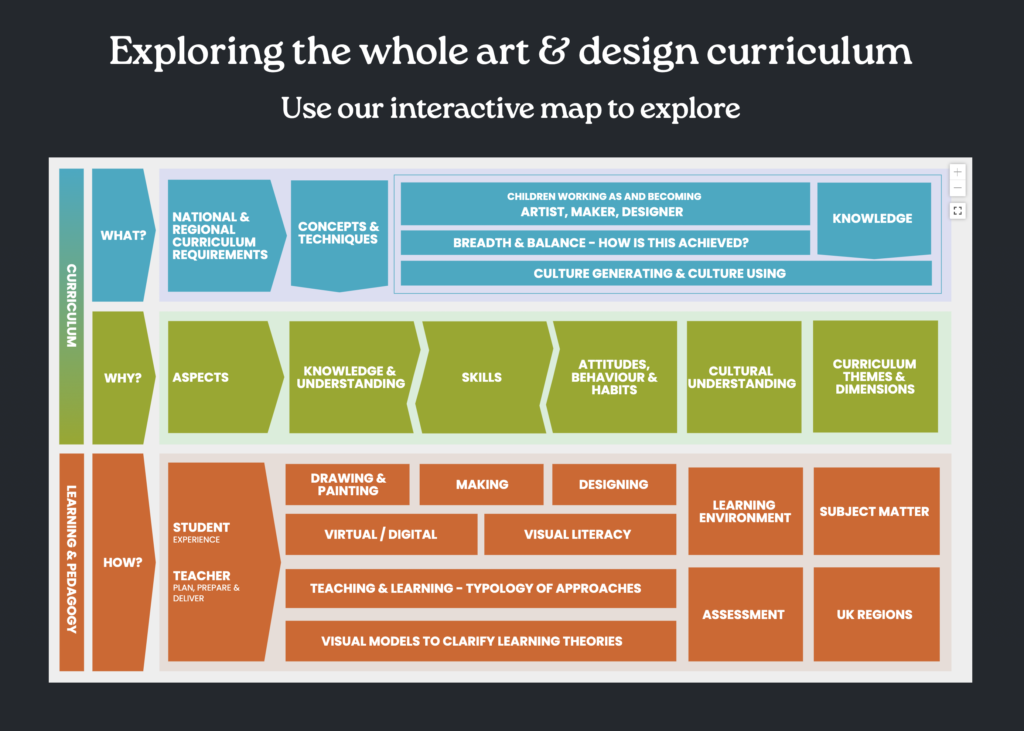FAQ to help you discover the Big Landscape and to plan, deliver and revise your curriculum.
What is the Big Landscape Map?
The Map sets out scope and potential of our subject. It is not intended for any one school to devise a curriculum that covers everything. This would not be possible. The Big Landscape Map will however, help you to plan, develop and review your curriculum objectives and to create a route to achieve these.
To view the first layer of the Big Landscape ‘Map’ use the tab on the menu bar, or use the orange button at the bottom of the homepage.
Visit the first layer of Big Landscape information by either clicking clicking on any of the blocks in the map or using the What, Why and How tabs on the menu bar.

What is a band?
The Big Landscape has several ‘bands’ of information to help you with planning, implementing and reviewing your curriculum or units of work.
Each band is a colour – blue, green or orange – and is comprised of ‘blocks’, laid horizontally in rows.
In each block, you will find information and definitions, further reading and research.
The blue band
The sky-blue band is called ‘What’ and sets out the content and concepts driving each lesson, project and overarching curriculum.
The green band
The green ‘Why’ band explores why we include these things – e.g. themes and dimensions; skills, knowledge and understanding – the purpose of learning. These are the things that will contextualise learning and shape your curriculum.
The orange band
The ‘How’ band is the foreground – it will help you decide how to organise and sequence learning and teaching.
How also refers to the environment and the way we might explore concepts, processes and ideas. It will help you make learning exciting, relevant and engaging. This band will help you to apply models of learning to inform better practice. (link to How landing page)
What is a block / In this section
Each band has its own set of blocks. There are 25 blocks in total; or 25 sub-headings in each section – they give meanings, information, ideas and inspiration to help with planning.
In the What band there are six blocks; Why has six; and How has 12.
To find more definitions, information and concepts, and to ‘drill down’ even more, you can hover over a block; or click on one of the ‘In this section’ menu headings. Alternatively, you can move across a band and explore other blocks. There is no one path or linear route across or down the blocks.
For more information visit: Exploring the Blocks.
Why do we say The Big Landscape is 'learner-centred’?
The Big Landscape toolkit is also an aide-memoir or a reminder of the richness of our subject and the learning that can be achieved in and through art, craft and design. It allows us to draw on the richness of our students’ unique experiences and voices. In doing so you will be able to create an engaging, ambitious and essentially bespoke unit of work or curriculum.
The Big Landscape avoids orthodoxies that do not address locality, community or content that is without relevance to your learners. For example, in the English national curriculum, we are asked to introduce pupils to ‘great artists’. But, does this mean artists, designers, makers, architects or photographers; does this include global majority artists, and what of contemporary artists or local creatives? NSEAD believe that what we select and include should be driven by our school ethos, the context, and the ‘next-step’ or sequential needs of our learners.
Is the Big Landscape only for NSEAD members?
Learn more about membership here
The Big Landscape was created so that every child and learner can enjoy the richness of our subject, and for every learner to be able to achieve their potential. The first 'layer' of information in The Big Landscape is open for everyone. To dig deeper into the Big Landscape, to use the Finding your Pathway checklist, or to download the large-format Atlas, you will need to be a member.
To download The Big Landscape Atlas visit this Big Landscape for members link to our website.
If you are thinking about joining NSEAD, visit our membership portal here
Our next phase is to add better practice case studies, as well as exemplification of high-quality curricula and units of work.
Where is the Big Landscape Atlas?
The Big Landscape Atlas 2024 (formally poster) was first published in AD issue 37, Summer 2023. All the poster's copy and much more, can be now accessed here in our online toolkit.
The Big Landscape Map has the same headings as our Atlas. The revised and updated Atlas (2024) can be downloaded by members by visiting NSEAD Big Landscape resources. You will need to log in and use your own personal NSEAD username and password.
How can my department get involved?
We are looking for art educators to help build the next phase of the Big Landscape. If you would like to share your own, your school, university or cultural organisation's best practice; or if you’ve tried out the Big Landscape and have feedback, please contact our Big Landscape team. Visit What’s next for the Big Landscape for contact details.